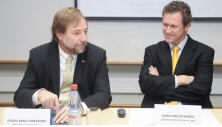As wise and balanced a summary as you will find of the fine art of dialogue and  engagement when it comes to the hard job of developing and integrating new transport arrangements into a space as varied and in many ways contradictory and conflicted as a 21st century city, in any part of the world. Bravo! With kind thanks to Christopher Zegras of MIT’s Department of Urban Studies and Planning, one of the conveners of this event, for sharing this with our readers. (You may also wish to check out the short note of conclusion of the editor.)
engagement when it comes to the hard job of developing and integrating new transport arrangements into a space as varied and in many ways contradictory and conflicted as a 21st century city, in any part of the world. Bravo! With kind thanks to Christopher Zegras of MIT’s Department of Urban Studies and Planning, one of the conveners of this event, for sharing this with our readers. (You may also wish to check out the short note of conclusion of the editor.)
First-Line Resources
- - > Helsinki Project - - > Mission Statement - - > Facebook - - > Twitter - - > EBT Program Library - - > Equity photo album - - > Equity/Transport videos - - > World Streets on EquityAdvisory Council
Latest Tweets
Tweets by EquityTSister Programs
 From World Streets
From World Streets- NOW!! 17 plus 1 reasons why I am prudently optimistic about the World Climate / Mobility / Work Transition for 2021/22
- “The Future Office Is Not About Place”
- *** WORLD STREETS INTERNATIONAL ADVISORY COUNCIL *** (to be updated, with full approval) _ _ _
- SAFE CITY STRATEGIES : MANAGING THE TRANSITION. (Working notes for a wide-open 2022 Collaborative Thinking Exercise)
- NEW 2030 ICELAND CLIMATE ACTION PLAN ANNOUNCED
- From Australia Archives: 41 Measures to Manage Traffic Congestion in your City
- World Streets Open 2021 Team Problem-Solving Initiative: Climate/Emergency Mobility/Space Jobs/Work Streets/Cars Private/Shared Vision/Strategy Equity/Women Action/Manage
- Why There Will Be Far Fewer Cars, But Many More Miles Driven
- Op-Ed: Coronavirus has exposed the fragility of auto-centric cities
- A CRISIS IS A TERRIBLE THING TO MISS
 From Safe Streets
From Safe Streets- Transportation Innovation and Reform: Finding the Way to Social Sustainability
- World Transport Policy & Practice – Vol. 18, No. 1
- We’ve never needed geniuses more than now.
- Weekend Musing: Less, More and Mozart
- Transport, Equity and Safe Streets: A Tale of Two Cities
- Late Night Thoughts on Equity from Helsinki
- Editorial: On the plane to Helsinki
- Crowdsourcing Equity/Transport/ Helsinki
- Equity/Transport 2012: Road map for Helsinki Stage 1
- Helsinki Focus Group Workshops – First guidelines
Useful Links
(Section to follow)Equity Reading Room









 IN the future, perhaps our time will be known as the first decade of the Bicycle Wars, with righteous armies fighting over traffic lanes, bike paths and sidewalks, indeed over the very purpose of the streets themselves. Like many wars, it’s a question of territory, and the pedestrian has been losing for years.
IN the future, perhaps our time will be known as the first decade of the Bicycle Wars, with righteous armies fighting over traffic lanes, bike paths and sidewalks, indeed over the very purpose of the streets themselves. Like many wars, it’s a question of territory, and the pedestrian has been losing for years. 








